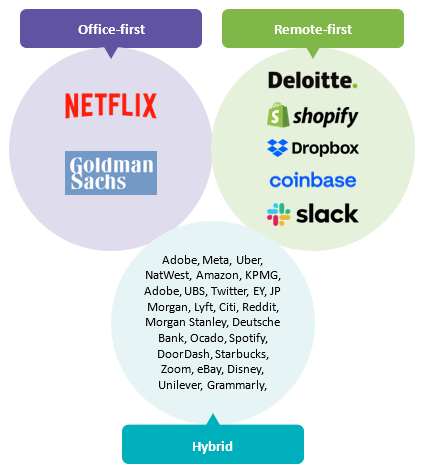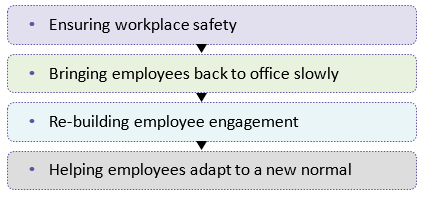
Back-to-office Strategies – How do you handle varied employee requirements?

Abstract/Business Case
- Introduction
The 2020 coronavirus outbreak reshaped most of the society. Right from schools, offices, to public spaces, everything changed overnight. With the implementation of lockdowns and standard operating procedures (SOP) of varying degrees, several companies had to send back their employees to work from home (WFH).
With the phenomena of WFH getting more common among employees, employees began seeing a change in the way they saw remote work and allowing employees to work away from offices. This set a path for a new phase of corporate culture, with companies having to step away from their understanding of inculcating corporate culture, from wearing suits and ties to office, to employees now relocating to tier-2 and tier-3 cities, with mental health growing of utmost concern throughout 2020.
Several companies have bounced back from the pandemic, in a better shape than they were before the outbreak, with many employers wanting their employees to return back to office. However, a lot has changed in the eyes of employees with respect to how they view returning and working physically from office.
- The Great Resignation
A year after the outbreak, the term “Great Resignation” was resonating through a lot of HR leaders and executives. The term was being used where masses of tech talent were resigning from their jobs for varying reasons. To understand this phenomenon better, it would help to know its major underlying reasons. Money, for one, wasn’t one of them.

- Toxic Culture - The most commonly cited reason for employees resigning was the toxic corporate culture, with up-to ten times higher than dissatisfaction with pay. The leading reasons for toxic culture, according to one report by Adecco, states failure to promote diversity, equity and inclusion, workers being disrespected, and unethical behavior.
- Job Insecurity and Restructuring – While the pandemic brought several physical changes, organizations also required cosmetic changes such as reorganization of teams in the wake of mass layoffs and change in skill requirements. Employees are said to be most affected by this change that poses a threat to their career stability.
- Performance Recognition – Employee morale is very important to the workplace, especially during an incredibly challenging period such as the pandemic. Employee recognition can come through many means that help recognize and reward strong performers. Employees who were largely felt unappreciated during this period felt the need to quit.
- Poor Pandemic Response – Certain employers were too late to decide on work modes through the pandemic, with employers hesitantly sending their employees back for only a few weeks to call them back, risking their health and well-being. Several employers have also been found lagging in terms of keeping a check on their remote employees’ mental health, leading to resignations.
- High Levels of Innovation – One of the most perplexing reasons, it may seem to employers, is certain employees’ response to high levels of innovations. A study found that-the more positively an employee talked about innovation at their company, the more likely they were to quit. This explains the fact that the attrition rates at the three most innovative Culture 500 companies, namely – Nvidia, Tesla, and SpaceX, were significantly higher than those in their respective industries.
Strategies adopted by Companies
While there is no one-size-fits-all approach that an organization can undertake in order to determine the future of work, several organizations are taking a crack at an approach that they may deem suitable for their workforce.
These strategies may be defined in three ways –
- Office-first
- Remote-first
- Hybrid

a. Office-first
While companies have had to move remotely during the lockdown, the leadership teams of some of these companies have realized that certain aspects of their work need to continue from offices.
This, however, may not be a blanket approach by companies that prefer an “office-first” approach. For e.g., Goldman Sachs CEO has shown eagerness in bringing his 60,000 employees back to office, fully vaccinated. However, the International Chief Executive has mentioned that employees in the London office need not be vaccinated but will have to use masks within the building. The Omicron variant turned out to be a set-back to the company as employees had to return to working from home.
When it comes to an office-first approach, there has been no leader as outspoken as Netflix CEO Reed Hastings, who publicly stated that he doesn’t “see any positives” from working from home. However, the leadership had to hold back on all plans until all their employees were vaccinated, and with the Omicron variant, work from home has been prolonged.
b. Remote-first
On the contrary to the “office-first” approach, a few companies have been proposing the remote-first strategy for the long-term. This doesn’t mean that employees cannot work from office but rather the default systems and processes will be geared around a distributed workforce.
Companies such as Deloitte has allowed its 20,000 employees to choose when, where and how they would work in the future. Dropbox announced in 2020 that they would turn into a ‘virtual first’ company, meaning that working outside of the office would be the primary experience for all employees and the day-to-day default for individual work.
Although many companies with such models still permit employees who want to work from office with office space, the office space in most cases has been reduced down to 20-25% of pre-pandemic capacities.
c. Hybrid
The hybrid strategy is the most widely adapted strategy for organizations and across seniority levels, be it entry level or executive level. Although what the term ‘hybrid’ means might vary drastically from company to company, given its wide adoption. For some organizations, this may mean giving employees the freedom to choose where they want to work and when they want work, while for others, it might mean designating certain days to work from office while working remotely for the rest of the time.
Companies that have chosen employees to come to office to work have either decided upon a prefixed set of days or have left it up to the employees to choose on days they would like to come to office. This varies from one day a week (Bank of England), two days a week (Amazon), to three days a week (Apple).
The “one day in the office” policy by Bank of England is still not the least figure of days a company needs its employees to come to work to office under the hybrid working model. Canva, an Australian graphic design platform company, has decided to commit to a long-term flexible work model where employees are expected to come to office just eight times per year.
Although, a vast majority of the companies who opt for the hybrid model have chosen between a two-day and three-day working week model. These include Amazon, Capital One, Citi, Deutsche Bank, Disney, EY, Google, KPMG, etc.
Employers kept on the fringes by Employees
As employers try to re-design and develop work strategies for the future to ensure teams collaborate in the best way possible and are able to optimize resources available to them, several employers are being brought to the fact that calling employees back to work isn’t as easy as it would be in the pre-pandemic era.
This comes as a recent survey found that at least six out of every 10 employees were willing to resign instead of returning to office; and if employers felt that attractive salary hikes would change this, the survey has further gone on to show that the same number of employees have disclosed that they are willing to reject higher-paying jobs that require to come to office.
Attrition rates have been at an all-time high across the globe, especially for tech talent. Candidates that fall under these functions having high attrition rates are more likely to reject offers that require returning to office due to better offers from companies that permit either lenient hybrid or remote-first work options. Such developments have even forced large, old-school employers such as Tata Consultancy Services to move to a hybrid mode of working known as the ‘25x25 model’, where only 25 percent of employees need to be in office at any given point of time, and need not spend more than 25 percent of their time in office.
Other major Indian IT companies such as Wipro and Infosys have adopted similar practices, with Wipro calling their employees to office two days a week, while Infosys has decided upon a similar hybrid model albeit for approximately 40-50 percent of its employees.
Considering that majority of employers fall far between the two extremes of ‘remote-first’ and ‘office-first’, and this is mostly decided in cases where there are extreme skills shortage to further incentivize talent, the most widely adapted strategy can be considered as the hybrid model for the “median-skilled” talent force that are under employment of large employers.
Startups, however, continue to push for a remote-first model, with companies such as Zerodha, Flyhomes, NoBroker, Meesho, AngelOne, Magicpin, Springworks. This includes allowing employees to work from exotic locations and also overseas, due to the lack of availability of niche skills that these startups usually require. Companies such as Meesho still expects its teams to come together for work once every quarter to enable team-bonding and keep employees in the loop with the company culture.
Employee-centric vs. Regimented approach
Whatever be the strategy adapted by the employer, gone are the days that the employer could write point-blank mails, directing employees to do a certain thing, or as in this case, return to office.
Employees value courteous employers that are mindful of not only their well-being, but also of their work-preferences. While a handful of the companies witnessed a loss-making pandemic, a majority of them – especially within the tech industry, outperformed their expectations, and all of this while employees were still working remotely. Both employees as well as employers mutually understand now that the impact of work from home isn’t as much as initially feared. The situation has brought both the parties to the table on different terms of negotiation in 2022, compared to what there might’ve been in 2019 and employers must be mindful of this change in terms.
An example towards this would be Apple, in its recent decision to set a fixed deadline to call its employees back to office by May 23. This move has resulted in a scathing letter being written from a few of its prominent employees, explaining that many employees are unhappy with the efforts to return to office. This group that has written the letter have dubbed themselves as “Apple Together”, listing several reasons why the return to office doesn’t make sense for the company and its employees.
Another example of a failed regimented approach comes from the example of Goldman Sachs, whose CEO had insisted that employees return to office for all five days of the week. This arrangement was initially proposed for June 2021, and was pushed back until February 2022 due to the Omicron variant. However, recent in-person attendance at the headquarters has averaged 60-70% over the course of a week.
Owing to this, several companies deciding on calling back their employees to work are doing so in either a staggered manner or are leaving it up-to individual teams to decide whether it is in best interest to return to office or not. Employers are bracing up to a future with an office filled at under 50% capacity and the need to reduce the number of seats.
Bringing Employees Back to Office
The need to bring employees back to office for most employers hasn’t come without the need to build a strategy in place. Employers across the globe have learnt several lessons over the course of the pandemic, which is of talent retention and talent acquisition. Employer branding has gained significance in the wake of the “Great Resignation”, with employers seeking expertise to re-brand their image in the digital space to help attract quality talent as well as retain high-performing employees.
Experts have outlined a few guidelines for employers to put in place before they decide to call employees back to office or decide on a practical hybrid mode of work.

- Ensuring workplace safety is one the most important requisites of returning employees due to the ongoing circumstances. Adequate space between workspaces by ensuring split schedules for employees, several other standards of procedures such as social distancing, temperature checks and ensuring that employees who test positive for COVID-19 are given the time they need to fully recover, are some of the measures recommended.
- A gradual call-back from employers is what is best recommended as it would be near to impossible to bring back the entire workforce at once, as was previously documented from the Apple and Goldman Sachs cases. Not only this, but according to PwC, the extended time away from office would mean that employees take more time to readjust to being back to a workplace, and hence it would also be a case of the employee mental well-being.
A few best practices would be to re-engage these new employees with an in-person on-boarding and pair them with buddies who can help them better adapt to their older working conditions. - Employers are required to rebuild their employee engagement system to keep in synch with the organization’s goals and to ensure that employees are re-affirmed that their career goals are held in the best interest of the organization. Employers will also need to acknowledge that employees were earlier closer to familial engagements such as children’s school activities and parents’ medical needs. Towards this, the employer will need to allow employees to continue allocating some of their time towards these activities to keep them in good spirit.
- Employees would also be shocked and left off-guard with changes in the way an organization works in the post-pandemic era. Several changes would require employees to get up-skilled or re-skilled to either fulfil previous roles or take on additional roles. Employers will need to be empathetic towards employees as they try to adapt to their new normal, and need to listen and reinforce patience and kindness towards the process and to involve employees in mapping out the solutions to each work environment challenge.
A Few Hybrid Workplace Management Tips
Hybrid workplace models are accommodating of managers and employees to split their working days between home and office. Employers can prioritize bringing back to office those employees who have little to no need to tend to their families, and decide upon the rest of the employees as and when the need arises. With this being said, it is still in the employers’ best interest to ensure that employees are still able to divide their workweek between working in office and at home.
While this may reduce costs and increase productivity, a hybrid working model requires higher level of management efforts such as updated policies, restructuring workflows, paying equal attention to home and office staff, thinking about efficient communication tools, and more. Employers will have to invest more in developing policies such as setting a fixed time employees need to be online, engage with co-workers, as well as engage HR activities with remote and hybrid teams, etc.
Creating a hybrid workplace policy
Depending on the needs, employers will need to work first and foremost on a hybrid workplace policy, by establishing what they expect from their employees. Developing a policy for mixed or remote work will set up rules for breaks, visits, equipment, cyber security, and the ratio of working hours at home.
It is necessary to included certain clauses in the standard employee contract such as:
- How many days should people work from home and in office?
- What work is better done in person than virtually?
- Whether specific employees be in office for both meetings and collaboration
Setting of expectations
In order to have a successful hybrid workplace, it is necessary to set up expectations with employees such as sharing work information, goals, and deadlines with all employees, especially those who work remotely.
To enable this efficiently, it is recommended to put in place a set of formal rules of interaction, such as,
- Staying online during specific hours
- Providing timely work updates
- Offering team-mates topics to discuss
Promoting employee communication
A hybrid workplace requires employers to have utmost trust and respect towards their employees by giving them their space and allowing them to perform. Under such an approach, it is important for the employer to promote holistic communication between employees by using communication tools on collaboration software that includes video conferencing, instant messaging, and automatic notifications.
Employers are expected to promote,
- All-hands meetings
- Friday evenings with online quizzes, games, and cocktail parties
- Lunches, etc.
Conclusion
A hybrid workplace model is not made for every workplace, however in places where it is applied, there may be several benefits such as including flexibility to work, higher revenue generation. A hybrid workplace is also vital for managers as it may need them to concurrently think about a comprehensive set of smart tools to support recruitment, adaptation, and engagement to build a long-lasting work relationship.
Leveraging some of the strategies that organizations have already successfully tried and tested, and learning from the failed strategies that some organizations have attempted may also be an important takeaway for organizations looking to finalize on what suits them best.
Related Insights:
View All
Get more stories like this
Subscirbe for more news,updates and insights from Beroe






